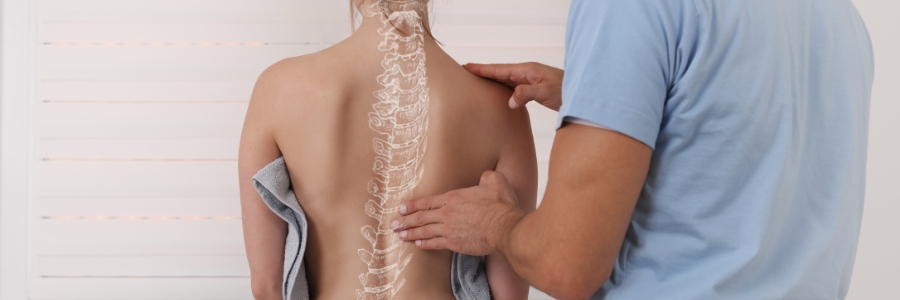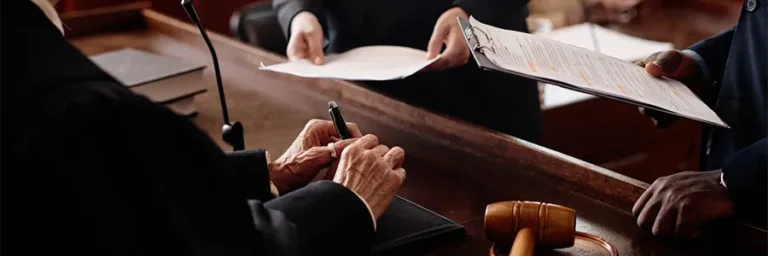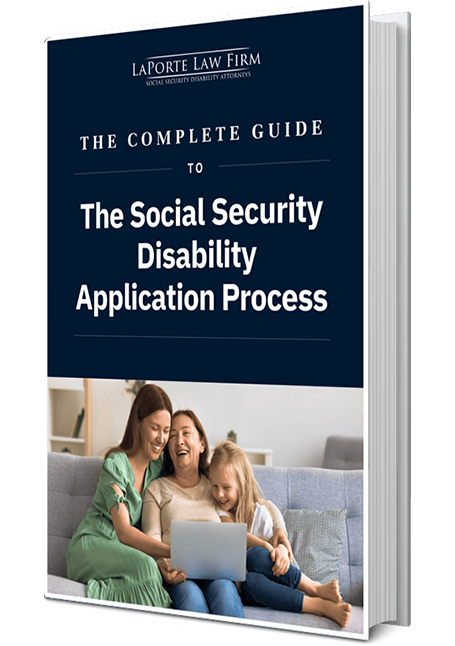
Scoliosis: A Primer
Scoliosis is an abnormal lateral curvature of the spine. The spine’s normal curves occur at the cervical, thoracic, and lumbar regions. With scoliosis, however, the spinal curvature occurs in the coronal or frontal plane. Scoliosis affects an estimated six to nine people in the United States. It typically develops in children aged 10–15 years old but it can develop as early as infancy or early childhood.
In most cases, the cause of scoliosis is unknown. There may be a combination of several factors that lead to scoliosis, including genetics, hormones, and changes in cell structure. In some cases, scoliosis can occur from a disease, disorder, or trauma.
Typical signs of scoliosis can include:
- Uneven shoulders
- One or both shoulder blades stick out
- One side of rib cage higher than the other
- Body leans to one side
- A difference in leg lengths
- A visibly curved spine
X-ray imaging is the primary diagnostic tool for scoliosis. If a person displays some of the typical signs of scoliosis, a doctor may need an X-ray to view the spine so that the degree of the spinal curve can be measured. Additional diagnostic procedures can include an MRI or a CT scan.
Back pain and stiffness is often the first symptom of scoliosis. People with scoliosis may also suffer difficulty walking, sitting or standing, curved posture, shortness of breath and fatigue, and nerve damage causing weakness, numbness, and pain in the legs and feet.
Every year, scoliosis patients make more than 600,000 visits to physician offices. Approximately 30,000 children are fitted with a brace every year. And an estimated 38,000 patients undergo spinal fusion surgery.
The goal of scoliosis treatment is to stop the progression of the curve and prevent deformity. In some cases of childhood or adolescent scoliosis, observation and repeated examination are the necessary treatment. These are used when a person is still growing and has a curve that is less than 20 degrees. If the scoliosis curve is more severe, bracing may be recommended. The brace applies corrective pressure on the growing spine to prevent the worsening of scoliosis. In other cases, surgery is a recommended treatment. Spinal fusion is surgery to connect two or more bones in any part of the spine.
Treatment of the symptoms of scoliosis usually involves treatment of back pain, one of the main problems caused by scoliosis in adults. Treatment of scoliosis includes painkillers, spinal injections, back braces, and surgery.
What are the types of Scoliosis?
The types of scoliosis are based on their causes: idiopathic, congenital, neuromuscular, and traumatic.
- Congenital: Congenital scoliosis stems from an embryological malformation of one or more vertebrae. This can occur in any location of the spine. Vertebral abnormalities cause deformities and curvatures of the spine because one part of the spinal column lengthens at a slower rate than the rest. Congenital scoliosis is present at birth and can be detected at a younger age.
- Neuromuscular: Neuromuscular scoliosis is secondary to neurological or muscular disease, such as cerebral palsy, spinal cord trauma, muscular dystrophy, and spina bifida. This type of scoliosis generally progresses more rapidly and often requires surgical treatment.
- Idiopathic: The term “idiopathic” means there is no definite cause, so this type of scoliosis is the diagnosis a doctor may make when all other causes are excluded. Idiopathic scoliosis can be caused by multiple factors that vary from person to person. It makes up the majority of scoliosis cases.
- Traumatic: Scoliosis can occur as the result of an accident or a surgery. These traumatic injuries can put intense pressure on the spine, causing the spine to curve.
Scoliosis is also classified according to the location of the curve within the spine and the direction in which it bends. Based on the location of the curve, the types of scoliosis are thoracic, lumbar, and thoracolumbar. Meanwhile, dextroscoliosis and levoscoliosis are types based on the direction of the curve.
- Thoracic: This type of scoliosis is the curvature located in the thoracic, or middle, portion of the spine. Thoracic scoliosis is a common form of scoliosis and causes a deformity in the rib cage.
- Lumbar: Lumbar scoliosis is the curvature located in the lumbar, or lower, part of the spine. It can cause one hip to sit higher than the other.
- Thoracolumbar: Located in the lower-thoracic and upper-lumbar vertebrae part of the spine, lumbar scoliosis can be a secondary effect of a neuromuscular condition.
- Dextroscoliosis: Dextroscoliosis is a type of scoliosis curvature that bends to the right.
- Levoscoliosis: Levoscoliosis is a type of scoliosis curvature that bends to the left.
How Does Scoliosis Impact Daily Life?
Scoliosis can affect the body in a variety of ways. In mild cases, there are no functional deficits because scoliosis is not commonly painful and only postural changes are noticeable. With a more moderate version of scoliosis, the postural changes are more noticeable. With more significant postural changes, there can be changes to gait, balance, and coordination. In a severe case, a person can suffer daily pain and disruption of quality of life. In addition to severe postural changes and pain, there may be mobility issues.
Scoliosis may cause additional complications including:
- Breathing problems: Severe scoliosis can disrupt lung function by narrowing the airways, limiting diaphragm movement, and reducing lung volume. Weakened lung function can be associated with respiratory failure. If scoliosis affects your lungs, you may experience some difficulty breathing.
- Heart problems: Scoliosis can contort the rib cage, restricting the heart’s ability to function properly. When severe scoliosis affects heart function, heart failure and pulmonary hypertension are possible.
- Neurological disorders: Scoliosis is associated with the decreased flow of the fluid that coats the brain and spinal cord to and from the brain. This can be associated with neurological deficits.
- Muscle imbalance: With severe scoliosis, the muscles that the spine curves toward are overused, and the muscles that the spine curves against are underused. When this occurs, the muscles on one side of the spine will be stronger. This muscle imbalance can worsen scoliosis.
- Digestive system issues: Abnormal curvature of the spine can constrict the esophagus, stomach, and small intestine. People with scoliosis often experience gastroesophageal reflux disease.
- Mental health issues: Scoliosis can be associated with mental health issues such as anxiety, depression, and personality disorders.
Is Scoliosis a Disability?
The Social Security Administration (SSA) defines disability as an inability to work due to a medically determinable physical or mental impairment that is either expected to result in death or has lasted or is expected to last for at least 12 months. The process to determine if you are disabled involves five questions:
- Are you working?
If you are working at substantial gainful activity levels, generally, you will not be considered to be disabled. Substantial gainful activity (SGA) is a level of work activity and earnings. A person who is earning more than a certain monthly amount is working at substantial gainful activity levels. In 2023, for a non-blind individual, the monthly SGA amount is $1,470.
If you have been diagnosed with scoliosis but continue to do work at substantial gainful activity levels, you may not be eligible for disability benefits.
- Is your condition severe?
Your condition is severe if it significantly limits your ability to do basic work activities. Basic work activities include activities such as walking, sitting, seeing, and remembering.
If your scoliosis impacts your ability to walk, sit, or do other basic work activities, the Social Security Administration will go on to the next step of the disability determination.
- Is your condition on the list of disabling impairments?
The SSA has a list of impairments for each of the major body systems. These listed impairments are so severe that they automatically meet the definition of disability. If the condition is not on the list, the SSA will decide if it is of equal severity of an impairment on the list. If it is, the claim will be approved.
Being diagnosed with a listed condition does not automatically equate to a finding of disability. The SSA’s listed impairments define the detailed symptoms, test results, or other data that show the conditions severe enough to be disabling.
Scoliosis is not currently defined in the listing of Social Security impairments. But scoliosis can cause serious spine injuries that are considered a listed impairment. If your scoliosis is severe enough to cause a serious spine injury, it may qualify under the Disorders of the Skeletal Spine Resulting in Compromise of a Nerve Root listing. The definition of the listing is as follows:
1.15 Disorders of the skeletal spine resulting in compromise of a nerve root(s) documented by A, B, C, and D:
- Neuro-anatomic (radicular) distribution of one or more of the following symptoms consistent with compromise of the affected nerve root(s):
- Pain; or
- Paresthesia; or
- Muscle fatigue.
AND
- Radicular distribution of neurological signs present during physical examination or on a diagnostic test and evidenced by 1, 2, and either 3 or 4:
- Muscle weakness; and
- Sign(s) of nerve root irritation, tension, or compression, consistent with compromise of the affected nerve root
- Sensory changes evidenced by:
- Decreased sensation; or
- Sensory nerve deficit (abnormal sensory nerve latency) on electrodiagnostic testing; or
- Decreased deep tendon reflexes.
AND
- Findings on imaging consistent with compromise of a nerve root(s) in the cervical or lumbosacral spine.
AND
- Impairment-related physical limitation of musculoskeletal functioning that has lasted, or is expected to last, for a continuous period of at least 12 months, and medical documentation of at least one of the following:
- A documented medical need for a walker, bilateral canes, or bilateral crutches or a wheeled and seated mobility device involving the use of both hands; or
- An inability to use one upper extremity to independently initiate, sustain, and complete work-related activities involving fine and gross movements, and a documented medical need for a one-handed, hand-held assistive device that requires the use of the other upper extremity or a wheeled and seated mobility device involving the use of one hand; or
- An inability to use both upper extremities to the extent that neither can be used to independently initiate, sustain, and complete work-related activities involving fine and gross movements.
Scoliosis can also cause digestive problems, respiratory disorders, and mental health impairments. If your scoliosis has created other physical impairments and your impairment meets the definition of a listed impairment, you will be found disabled. If your impairments do not meet or equal a listed impairment, the Social Security Administration will go on to the next step of the disability determination.
- Can you perform your past relevant work?
If your impairment does not meet or equal the listing of impairment, the Social Security Administration will determine the claimant’s residual functional capacity. The residual functional capacity assessment is a determination of the maximum ability to do sustained work activity on a regular and continuous basis despite the limitations and restrictions of the claimant’s medical impairments. If you have been diagnosed with scoliosis and the SSA considers it to be a severe impairment, the residual functional capacity assessment is an accounting of your abilities, despite the limitations and restrictions that stem from a severe scoliosis case.
At step four of the sequential evaluation, after taking into consideration your residual functional capacity assessment, the SSA will determine if you can perform your past relevant work. Your past relevant work is work performed at the substantial gainful activity level in the last 15 years.
If your scoliosis prevents you from performing your past work or you have no relevant past work, the SSA will go on to the next step of the disability determination.
- Can you do any other type of work?
At step five of the sequential evaluation, the Social Security Administration will determine if there is any other work that exists that the claimant can perform. When considering if the claimant can perform any other work, the adjudicator will consider the limiting effects of scoliosis as well as the claimant’s age, education, and work experience.
To be found disabled, your scoliosis has to be severe enough to prevent you from performing your past work or transferring your skills to any other full-time work.
What Should You Do to Receive Social Security Disability Benefits for Scoliosis?
If you believe that your scoliosis is severe enough to prevent you from performing your past work or performing any other full-time work, it is important to review the Social Security Administration’s disability criteria. When initiating a disability case, you will need to gather the appropriate documentation, including medical records, work history, and other relevant information.
The Social Security Administration will request and obtain documentation and medical records to review the symptoms of your scoliosis to determine what you can and cannot do despite your disability. This treatment record is important to prove your disability case.
It is important to have objective medical evidence that shows the severity of your scoliosis. To have the best chance of approval, it is important there is an X-ray, an MRI, or a CT scan showing the severity of scoliosis. If scoliosis has created additional impairments, it is important to have objective measures of those impairments to demonstrate your limitations.
Once the appropriate documents are compiled, you are ready to file an application for disability benefits. If your application is denied, you have the opportunity to appeal the denial. For an increased chance of success at the application and appeal stages, you may seek the help of a disability attorney who can guide you throughout the entire process
Can Scoliosis Be Treated and How Does That Affect Your Disability Benefits?
Depending on the severity of your scoliosis, it can be treated with pain management, bracing, or surgery. The severity of your scoliosis will determine the treatment options.
- Bracing: Brace treatment is used to prevent scoliosis from getting worse. Patients may be fitted with either a rigid plastic bracing or a soft brace. Some braces are only worn at night but most common daytime braces are worn 16 –23 hours daily.
- Surgery: Surgery is necessary in severe cases to help straighten the curve of the spine and prevent it from getting worse. Surgical options can include spinal fusion, expanding rods, and vertebral body tethering.
If you receive treatment for your scoliosis but it continues to be severe enough to prevent you from performing full-time work, you may still be eligible for Social Security disability benefits. If your scoliosis treatment is successful and you can improve to the point where you are able to return to work, you may be eligible for a closed period of disability. A closed period of disability is a period of time that lasts at least 12 months, where you were not able to perform work.
If the Social Security Administration determines that your scoliosis is severe enough to prevent full-time work, you will be eligible for Social Security disability benefits. After you are approved for disability benefits, the SSA will periodically review your case to determine whether you are still disabled. If your scoliosis treatment improves your condition, the SSA will review your case to determine if you can return to work performing substantial gainful activity.
Key Takeaways
- Scoliosis can be a disability that qualifies you for Social Security disability benefits but it has to be severe enough to prevent you from performing your past relevant work or transferring your skills to perform other full-time substantial gainful activity. A mild form of scoliosis will not be disabling by itself.
- Medical evidence is essential to a Social Security Disability case. To give yourself the best chance of success in a disability case, it is important to have objective tests that document the severity of your scoliosis.
- Research shows that having a representative increases the probability of initial awards and reduces the need for appeals. If your scoliosis is severe enough to prevent full-time work, contact a representative to get information about filing an application or appealing a denial.
Our Social Security disability attorney representatives specialize in helping clients navigate the Social Security disability process from the application stage through all appellate stages. Our attorneys have years of experience filing disability applications and appeals. Once the claim is submitted, a representative can speak to the Social Security Administration on your behalf. Our representatives have years of experience corresponding with the analysts and examiners at the Social Security Administration. If your claim is denied at the application stage, our representatives can help you appeal a denial.
Before you file a Social Security disability application, it is important to gather all necessary documentation. You will need to compile information about your past 15 years of work and your medical treatment history. Once this information is compiled, you can file for Social Security disability benefits by filling out a series of disability forms.
If you have questions about the disability application, contact our representatives for a free consultation.
If your Social Security disability claim was recently denied, you have the right to file an appeal. The first appeal is called the Request for Reconsideration. During the reconsideration stage, the Social Security Administration takes a second look at your case to determine your disability.
If your Request for Reconsideration is denied, you can file a second appeal. This appeal is called the Request for Hearing. At a hearing, you have the opportunity to testify before an administrative law judge who will decide your case.
The most important thing to remember is the time frame in which you can file the appeal. Generally, you have 60 days from the date you receive the denial notice to ask for an appeal.
Severe scoliosis cases can be difficult to treat. It can be further complicated by additional conditions that scoliosis causes, such as pulmonary, digestive, or cardiovascular disorders. These conditions can become permanent.
The Social Security Administration’s definition of a permanent disability is a disability that is expected to last or has already lasted at least 12 months. You may be eligible for disability benefits if your severe scoliosis and the condition it causes have lasted or will last at least 12 months.
If you are currently receiving disability benefits for an impairment related to your disability, the Social Security Administration will periodically review your case to determine if you are still disabled. These reviews typically occur every three or every seven years. During a review, the SSA will gather additional information about your medical condition. If your medical condition has improved, the SSA will determine if it has improved enough to allow you to work. If your scoliosis has improved and the SSA has decided you can work, your benefits will stop.















